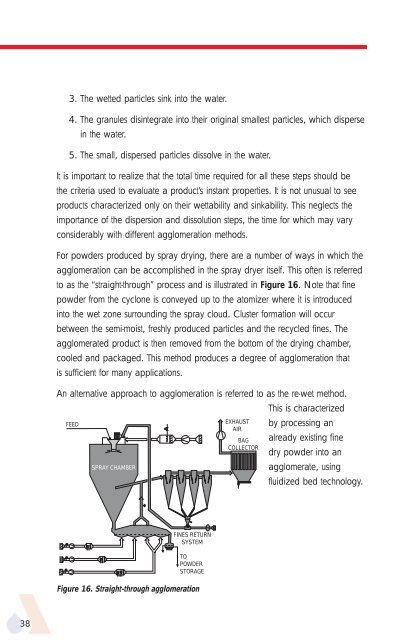APV Dryer Handbook - Umbc
APV Dryer Handbook - Umbc
APV Dryer Handbook - Umbc
You also want an ePaper? Increase the reach of your titles
YUMPU automatically turns print PDFs into web optimized ePapers that Google loves.
38<br />
3. The wetted particles sink into the water.<br />
4. The granules disintegrate into their original smallest particles, which disperse<br />
in the water.<br />
5. The small, dispersed particles dissolve in the water.<br />
It is important to realize that the total time required for all these steps should be<br />
the criteria used to evaluate a product’s instant properties. It is not unusual to see<br />
products characterized only on their wettability and sinkability. This neglects the<br />
importance of the dispersion and dissolution steps, the time for which may vary<br />
considerably with different agglomeration methods.<br />
For powders produced by spray drying, there are a number of ways in which the<br />
agglomeration can be accomplished in the spray dryer itself. This often is referred<br />
to as the “straight-through” process and is illustrated in Figure 16. Note that fine<br />
powder from the cyclone is conveyed up to the atomizer where it is introduced<br />
into the wet zone surrounding the spray cloud. Cluster formation will occur<br />
between the semi-moist, freshly produced particles and the recycled fines. The<br />
agglomerated product is then removed from the bottom of the drying chamber,<br />
cooled and packaged. This method produces a degree of agglomeration that<br />
is sufficient for many applications.<br />
An alternative approach to agglomeration is referred to as the re-wet method.<br />
This is characterized<br />
FEED<br />
EXHAUST<br />
AIR<br />
by processing an<br />
BAG already existing fine<br />
COLLECTOR<br />
dry powder into an<br />
SPRAY CHAMBER<br />
agglomerate, using<br />
fluidized bed technology.<br />
FINES RETURN<br />
SYSTEM<br />
TO<br />
POWDER<br />
STORAGE<br />
Figure 16. Straight-through agglomeration











